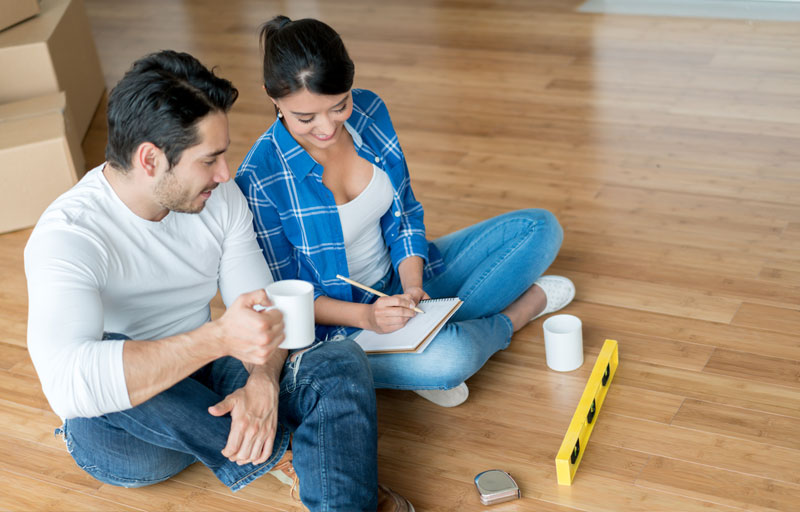Moving into a new home is an exciting time. One of the most enjoyable things you get to do in your new place is to put your stamp on it so your home reflects your style and taste.
It’s fairly common to move into a new home and to discover that you don’t have enough furniture or to struggle with how to make what you already have work.
Many retailers who sell furniture, like Pier 1 Imports and Crate and Barrel are now making it easier than ever to decorate your home by offering customers access to things like free design software and other resources on their websites.
For example, Crate and Barrel’s Mood Board Tool helps you visualize your style by giving you a place to put furniture, lighting and decor all together in one spot and see how they all work as a group.
Pier 1 Imports offers an entire “Inspiration” section on their website, designed to give you ideas and how-to tips on everything from how to hang curtains to making a perfect tablescape.
While you can certainly take advantage of design programs or even hire a professional, neither of these are essential to get that designer look you’re hoping for. Coming up with the ideal design for your furniture and decor can seem like a daunting task, but with a few tips and tricks you can make your home the beautiful, inviting space you’re craving.
Here are some of our best suggestions for decorating your new home like a pro designer
Furniture & Lighting
When it comes to decorating a room, the furniture and lighting set the tone. Whether you’re going for traditional, modern or something in the middle, choosing the right pieces helps make your vision come to life. Larger furnitures pieces are an investment and something you’re going to be living with for several years, so figuring out the best layout and the optimal size for the pieces before you buy is a very wise decision.
Living Room
Most living rooms start with great seating. Whether you want a space that’s perfect for entertaining and conversation or something more geared towards reading and media, the set up of your furniture can be done in a way to best facilitate these activities.
One of the most important rules of thumb to keep in mind as you start is to ensure you leave enough space in between furniture, otherwise, the room will seem cramped. The ideal placement is 30 inches between pieces where you need to walk around, and 14 to 18 inches between the coffee table and sofa so that you can still easily reach drinks or items on the table. For face-to-face conversation, seating should be placed no more than eight feet apart. If your living room is extra large, you can create groupings of furniture that function as little islands. For best use of space, we like the combination of a sofa and two armchairs. The chairs will balance out the visual weight of the sofa and keep the room from feeling too heavy.
In terms of how to set up your furniture, start by looking at what the focal point of the room is going to be, like a bank of windows or the TV. If you feel like the room is lacking in a natural focal point, you can create one. Hang a large piece of art on the wall, or create a vignette of special items on a bookshelf or console. The idea is that you orient the seating so it takes advantage of the focal point.
Next, you’ll want to choose some side tables that fit the space and allow for the best traffic flow. End tables should be used as anchors for either end of the sofa and provide a place for drinks, table lamps, and other items.
Using round pedestal tables softens the space since there are no hard edges and the curves make them easier to navigate around.
Another option are nesting tables as it allows you to incorporate expandable pieces that are flexible and can be used as needed.
The living room is often the hub of the house and requires a fair amount of storage. Look for multipurpose pieces, like an ottoman with storage, to make the most of the space available. If it’s a smaller room, free-standing pieces for storage are an excellent option. In a larger room, you may want to consider built-ins. (Remember, you’ll also need storage near the TV for media items as well).
Finally, you’ll want to select lighting that enhances the activity taking place in the space, so if you want to create a reading space in your living room, you should look for a floor lamp that gives off a direct and bright light. For TV watching, consider a wall mount light behind the screen to prevent eye strain.
Overall, your lighting should offer a good mix of bright and soft lights that can be used to suit whatever the mood is at the time.
Dining Room
No dining room would be complete without a table, so that’s the best place to start. When selecting a dining table, there’s no shortage of options. Depending on the size and shape of your dining space, you want to select a table and chair that fit the scale of the space:
Circular tables let you see everyone at the table and work well in square rooms or tight spaces.
Rectangular tables provide limited seating but work best in rectangular rooms. You can usually find the largest variety in length and width so these are often the easiest to scale to a room.
Oval tables also work well in rectangular dining rooms. Look for ones that come with extra leaves so you can expand as needed when entertaining.
When selecting your chairs, the rule of thumb is that you should allow 20 to 24 inches and a depth of 15 inches per place setting.
Next you’ll want storage, and dining room storage also comes in many shapes and sizes. Sideboards, buffets, occasional tables, or wall shelves all can work in the space. If you can use a piece that incorporates storage for things like china, barware or linens, this is ideal.
When it comes to lighting your dining space, choose a glare-free light fixture for above the table. You want it to be bright enough that you can what’s on your plate. Dimmers on the overhead light are perfect for dining spaces as it allows you to soften the light and create ambiance when you want to.
Bedroom
When it comes to the bedroom, the bed is the star of the show. Placement of your bed will greatly depend on the layout of the room, but don’t shy away from placing the bed in a slightly unusual way if it will help make the most of your floorspace.
The optimal bed placement should allow for a minimum of two feet on each side of the bed so you can easily get in and out. Makes sure the bed isn’t too close to the door otherwise it may impede traffic flow.
To make the best use of your floorspace, go for dual use where possible, like using small dressers as your bedside tables. These provide storage and a side table, both of which are needed. If you have a walk-in closet, considering placing a dresser in there to free up more space in the room.
Bedroom lighting should offer a combination of muted and bright light. You need bright spots in the room for things like getting dressed, but you’ll also want softer lights for when you’re trying to relax and wind down. Also, you’ll want to make sure you have either table or wall mount lights that you can easily control from your bed.
Pictures & Other Artwork Throughout the Home
One area that homeowners tend to get stuck on is what to put on the walls. This is truly the finishing touch in any room, so this needs to be part of your decorating plan. Pictures and artwork are deeply personal and what you like or don’t like comes down to a matter of personal taste. Whether you’re grouping family photos or hanging a treasured painting, there are certain guidelines you can follow to make sure your pictures and artwork look their absolute best.
Before you start putting holes in your walls, you need a plan! If you’re doing a group of pieces, trace out each one on some craft paper, label what it is, and cut it out. Then use painter’s tape to add your templates to the wall and figure out exactly where everything should be placed.
The biggest mistake people make with artwork is hanging it too high. The center of the image should be at eye level. In living rooms, people are usually sitting, so artwork should be lower.
A good way to ensure you’re placing artwork at the right height is to hang it one hand width above the sofa. When hanging multiple pieces around the room, don’t try to make the bottoms or tops of frames level. Level the middle of the images.
Any pieces you select should be in scale with the furniture. Having something too small or too big can make the room look off-kilter, so a good rule of thumb when choosing artwork to go with large furniture like a sofa or sideboard is that it should be two-thirds of the size of the furniture piece.
Finally, if you have a large blank wall to cover, consider a gallery arrangement. You can create visual interest by including more than just framed art, such as decorative plates or other treasures. Position the most prominent piece at eye level in the center and work outward.
When the time comes to actually start decorating your spaces, don’t be afraid to move around things and try different placements. Sometimes what we think will work doesn’t actually look that good when we do it, so not worrying about having everything done the “right” way is the best route to coming up with a design that suits your home, your taste, and most of all, your lifestyle.
Westcott Homes offers modern living and smart design for today’s active families, in neighborhoods with room to grow. Our flexible floorplans, durable Pacific Northwest exteriors and luxurious interior details add up to a home you’ll delight in every day, and for years to come.







